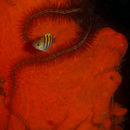Diagnostic Description
(
Inglês
)
fornecido por Fishbase
Greenish yellow above, shading to white below, with 5 prominent vertical black bars that narrow toward belly (Ref. 26938). A faint sixth bar may be present posteriorly on caudal peduncle; a black spot at upper base of pectoral fin. The adult male becomes dark bluish, the black bars thus less conspicuous on the body (Ref. 13442).
- licença
- cc-by-nc
- direitos autorais
- FishBase
- Recorder
- Grace Tolentino Pablico
Life Cycle
(
Inglês
)
fornecido por Fishbase
Oviparous, distinct pairing during breeding (Ref. 205). Eggs are demersal and adhere to the substrate (Ref. 205). Males guard and aerate the eggs (Ref. 205).
- licença
- cc-by-nc
- direitos autorais
- FishBase
Morphology
(
Inglês
)
fornecido por Fishbase
Dorsal spines (total): 13; Dorsal soft rays (total): 12 - 13; Analspines: 2; Analsoft rays: 10 - 12
- licença
- cc-by-nc
- direitos autorais
- FishBase
- Recorder
- Grace Tolentino Pablico
Trophic Strategy
(
Inglês
)
fornecido por Fishbase
Inhabits inshore and offshore coral or rocky reefs (Ref. 7247). Juveniles are common in tide pools while adults found over shallow reef tops. Adults frequently form large feeding aggregations of up to several hundred individuals. It feeds primarily as a browsing herbivore (Ref. 275). Food items include algae, small crustaceans and fish, and various invertebrate larvae (Refs. 3139, 127989). Feeds on spinner dolphinsâ feces and vomits at Fernando de Noronha Archipelago, southeast Atlantic. The offal feeding may be regarded as a simple behavioral shift from plankton feeding to drifting offal picking. Also, juveniles hold cleaning stations together with the doctorfish (Acanthurus chirurgus) and the blue tang (Acanthurus coeruleus) and graze algae as well as pick molted skin and parasites from green turtles (Chelonia mydas ). This behavior is preceded by a characteristic inspection usually followed by feeding nips on the turtlesâ skin (head, limbs, and tail), as well as on the carapace. The most inspected and cleaned body parts are the flippers (Ref. 48727, 51385). Littoral species. Forms small to medium groups (Ref. 127989).
- licença
- cc-by-nc
- direitos autorais
- FishBase
Biology
(
Inglês
)
fornecido por Fishbase
Juveniles are common in tide pools while adults are found over shallow reef tops. Adults frequently form large feeding aggregations of up to several hundred individuals. Food items include algae, small crustaceans and fish, and various invertebrate larvae (Ref. 3139). At Fernando de Noronha Archipelago, this species feeds on spinner dolphinsâ feces and vomits. The offal feeding may be regarded as a simple behavioral shift from plankton feeding to drifting offal picking. Also, juveniles may hold cleaning stations together with the doctorfish (Acanthurus chirurgus) and the blue tang (Acanthurus coeruleus) and graze algae as well as pick molted skin and parasites from green turtles (Chelonia mydas ). This behavior is preceded by a characteristic inspection usually followed by feeding nips on the turtlesâ skin (head, limbs, and tail), as well as on the carapace. The most inspected and cleaned body parts are the flippers (Ref. 48727, 51385). Adult males adopt a bluish ground color when guarding eggs. Oviparous, distinct pairing during breeding (Ref. 205). Eggs are demersal and adhere to the substrate (Ref. 205). Attracted to divers who feed fish. Marketed fresh (Ref. 3139). Has been reared in captivity (Ref. 35420).
- licença
- cc-by-nc
- direitos autorais
- FishBase
Importance
(
Inglês
)
fornecido por Fishbase
fisheries: minor commercial; aquarium: commercial; price category: unknown; price reliability:
- licença
- cc-by-nc
- direitos autorais
- FishBase

